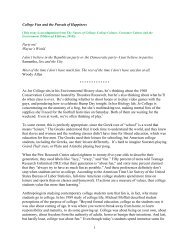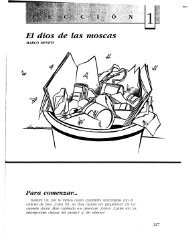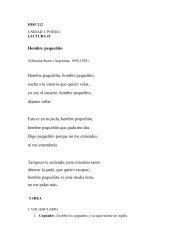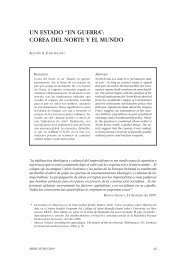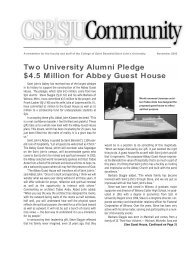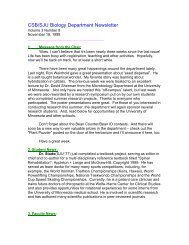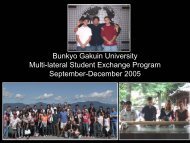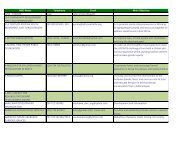Maple Syrup Season 2007 – Summary - College of Saint Benedict ...
Maple Syrup Season 2007 – Summary - College of Saint Benedict ...
Maple Syrup Season 2007 – Summary - College of Saint Benedict ...
You also want an ePaper? Increase the reach of your titles
YUMPU automatically turns print PDFs into web optimized ePapers that Google loves.
<strong>Maple</strong> <strong>Syrup</strong> <strong>Season</strong> <strong>2007</strong> <strong>–</strong> <strong>Summary</strong><br />
The maple syrup operation this year was run by William Mock (long-time friend <strong>of</strong> St.<br />
John’s and the Arboretum), Sarah Gainey (<strong>Saint</strong> John’s Arboretum), and Stephen Saupe<br />
(CSB/SJU Biology Department). Sarah’s main role was as our educational/public liaison while<br />
Bill and Steve served as the production managers. Br. Walter Kieffer, OSB., served, as always,<br />
as our chief consultant and spiritual advisor. We also received advice and assistance from Tom<br />
Kroll, <strong>Saint</strong> John’s Arboretum Director. We were assisted by many volunteers (see below), two<br />
<strong>of</strong> whom deserve special recognition for the countless hours that they spent helping: Kevin<br />
Sittauer (a forester) and Gary Gillitzer (an instructor in the CSB Nursing department).<br />
Bill, Sarah, Walter, Tom, and Steve held a “pre-season” planning meeting on November<br />
16 th (2006). The main purpose <strong>of</strong> this meeting was to set the dates for tapping and our festivals,<br />
and to divvy-up responsibilities for assembling bags and other tasks. At this meeting we also<br />
discussed and adopted a Mission Statement for our operation (appended) and we discussed<br />
possible renovations to the Sugar House. We generally agreed that we need more space for<br />
visitors and we especially want to minimize people (particularly kids) walking around the hot<br />
evaporator.<br />
One <strong>of</strong> our first major activities to get ready for syruping was assemble the sap sacks.<br />
Sarah organized this venture which featured about 20 volunteers working together in the garage<br />
(Fig 1). We followed up the fun with pizza and assembled about 800 bags about three hours.<br />
On Saturday, March 10 we were joined by over 75 volunteers to help tap our trees.<br />
Walter was the main tapper with Steve and Sarah pinch-hitting when he needed a rest. We put<br />
out about 800 taps. While the crew tapped, Bill and others assembled and cleaned the evaporator<br />
and sugar shack. A highlight <strong>of</strong> the day was a pre-tapping ceremony that featured a prayer by<br />
Br. Walter (appended) and a Native American blessing by Jane Barth. By the end <strong>of</strong> the season,<br />
classes and other visitors installed more than 150 additional taps for a grand total <strong>of</strong> 965 taps.<br />
The first day that we collected sap was 18 March and our last day was 14 April. We<br />
pulled the taps on 21 April. Our final cleanup day was 5 May (see Table 1).<br />
By the end <strong>of</strong> the season, we made 116 gallons <strong>of</strong> syrup (Table 2). Considering that we<br />
put out 965 taps and historically make 0.7-0.8 quarts <strong>of</strong> syrup per tap, we expected to make about<br />
170 gallons <strong>of</strong> syrup (= 965 taps x 0.7 quarts/tap x 1 gallon/ 4 quarts). One reason why our yield<br />
was lower than anticipated is because the weather wasn’t particularly cooperative. It was either<br />
too warm or too cold for adequate sap flow resulting in too few “sap days” (night temperatures<br />
were below freezing followed by daytime temperatures above freezing). Interestingly, during the<br />
early part <strong>of</strong> the season there were some wonderfully warm days but there was little sap flow<br />
except from trees in low-lying areas. We (and local syrup-makers) attributed these low sap flows<br />
on what should have been a good “sap day” to frozen soils. With little snow cover and a rather<br />
severe cold snap in mid-late winter, it resulted in a very deep frost line, which apparently slowed<br />
the flow <strong>of</strong> sap from most trees. As a consequence, we only collected 3675 gallons <strong>of</strong> sap, or an<br />
average <strong>of</strong> 3.8 gallons per tap. Based on data to 1972, our historic average sap collected per tap<br />
is 7.4 gallons.<br />
Although the flows weren’t great, we were fortunate that the sugar concentration <strong>of</strong> the<br />
sap was higher this year than average. Our sap/syrup ratio this year was 31.7, which is<br />
considerably better than our average 40.1. Based on the Rule <strong>of</strong> 86, our average sugar<br />
concentration this season was 2.7%, which is much better than our historic average (2.0 %).
Although our syrup production was a little disappointing, the number <strong>of</strong> people who<br />
visited our operation was definitely not. We were assisted by approximately 153 total volunteers<br />
who donated more than 600 hours <strong>of</strong> service (and this doesn’t even include the actual syrup team<br />
leaders). Our volunteers included members <strong>of</strong> the monastery (e.g., Fr. Bruce Wollmering, Br.<br />
Knute Anderson, Br. Mark Kelly, Br. Gregory Ebensteiner, Br. Brad Jennings, Br. <strong>Benedict</strong><br />
Leuthner), students, alumni, staff, and friends <strong>of</strong> St. John’s. As a thank you to our volunteers, we<br />
handed out small 40mL bottles <strong>of</strong> syrup and buttons with the maple syrup logo and ‘<strong>Saint</strong> John’s<br />
<strong>Maple</strong> <strong>Syrup</strong> Crew’ on them. We hosted two Festivals that were attended by more than 600<br />
people (and more than 100 volunteers) and one festival was featured in a full-page article in the<br />
St. Cloud Times (“Participants tap, taste maple syrup,” March 25, <strong>2007</strong>). We were also featured<br />
in an article in The Record (“Sap-collecting season begins”, March 15, <strong>2007</strong>).<br />
We provided educational tours to more than 600 students, from preschoolers to high<br />
schoolers. CSB/SJU students also were involved, incluing ten sections <strong>of</strong> Biology 221 lab<br />
visiting the sugar shack for a lab session. In addition, Diane Veal-Jones CSB/SJU Symposium<br />
class used our operation as part <strong>of</strong> a service-learning experience, and two other symposium<br />
pr<strong>of</strong>essors, Jean Lavigne and Pam Immelman, brought their classes for a sugar shack tour.<br />
Karen Bengtson used the maple syruping classes as an introduction to running effective field<br />
trips for her pre-service education majors. Her students not only participated in the field trips<br />
with 5 th graders from Discovery Elementary, but also were able to visit their classroom before<br />
and after their field trip to see how the teachers incorporate it into their daily curriculum.<br />
Additionally, Arboretum intern Rob Matuska wrote a market research paper investigating the<br />
role <strong>of</strong> natural foods such as maple syrup in the local economy. We also gave two formal<br />
presentations about the operation <strong>–</strong>a CSB/SJU Friday Forum (ca. 25 attendees), and Central<br />
Minnesota Audubon Society (20 attendees).<br />
As always, we had a fantastic year and enjoyed sharing this <strong>Benedict</strong>ine tradition with<br />
many people; our visitors learned first-hand about the <strong>Benedict</strong>ine values <strong>of</strong> work, community,<br />
and land stewardship.<br />
Our yearly statistics are summarized in Tables 1, 2 & 3.
Table 1. Sap Collection Data <strong>–</strong> Spring <strong>2007</strong><br />
Date Sap tanker Sap collected<br />
loads (gal)<br />
18 Mar 2.3 402.5<br />
19 Mar 2.5 437.5<br />
24 Mar 2.5 437.5<br />
28 Mar 1.2 210.0<br />
8 Apr 1.0 175.0<br />
12 Apr 6.0 1050.0<br />
13 Apr 5.0 875.0<br />
14 Apr 0.5 87.5<br />
total 21 3675<br />
Table 2. <strong>Syrup</strong> Production Data <strong>–</strong> Spring <strong>2007</strong><br />
Date <strong>Syrup</strong> (gal)<br />
24 Mar 8<br />
29 Mar 32<br />
14 Apr 32<br />
15 Apr 25<br />
20 Apr 15<br />
26 Apr 4<br />
Total 116<br />
Table 3: <strong>Summary</strong> <strong>–</strong> <strong>Maple</strong> <strong>Syrup</strong> <strong>Season</strong> <strong>2007</strong><br />
# sap collection days 8<br />
Tanker loads <strong>of</strong> sap 21<br />
Total sap collected (gal) 3675<br />
<strong>Syrup</strong> produced (gal) 116<br />
Ratio (sap/syrup) 31.7<br />
Number <strong>of</strong> volunteers At least 153<br />
Hours <strong>of</strong> volunteer time (excluding<br />
leaders)<br />
At least 617<br />
Student visitors Over 600
Figure 1. Sarah demonstrating sap-sack assembly to volunteers<br />
Figure 2. Walter Kieffer, O.S.B. leading the group in a prayer <strong>of</strong> thanks for maple syrup. To his<br />
right is Jane Barth, who followed Br Walter and presented a Native American <strong>of</strong>fering <strong>of</strong> thanks.<br />
Figure 3. Steve Saupe looking pensive before the start <strong>of</strong> tapping for the <strong>2007</strong> season.<br />
Figure 4. Bill Mock (green jacket) and Br Walter setting the pans in the evaporator.
Mission Statement<br />
The mission <strong>of</strong> the St. John’s <strong>Maple</strong> <strong>Syrup</strong><br />
operation is to continue the long-standing<br />
<strong>Benedict</strong>ine tradition <strong>of</strong> making maple syrup from<br />
the sweet sap <strong>of</strong> the abundant sugar maple trees<br />
(Acer saccharum) that grow on campus.<br />
Approximately every other year since 1942, the<br />
monks and their friends have gathered together to<br />
tap trees, collect sap and boil it down to produce a<br />
heavenly confection that is a testament to the<br />
forest stewardship <strong>of</strong> the <strong>Benedict</strong>ine community.<br />
In addition, we strive to provide opportunities for<br />
the St. John’s community, including monks,<br />
students, and the public at-large, to learn about<br />
and participate in the process <strong>of</strong> making this<br />
sustainable forest product.<br />
adopted: November 2006
A Blessing - by Walter Kieffer, O.S.B. (for the opening <strong>of</strong> the <strong>2007</strong> maple<br />
season)<br />
Oh, God <strong>of</strong> all goodness.<br />
In the beginning you created the earth and divided it between the lands and the<br />
waters.<br />
On the lands you created all kinds <strong>of</strong> vegetation; plants and trees <strong>of</strong> all kinds, and<br />
commanded them to cover the earth, providing both shelter and food for all.<br />
Of the multitude <strong>of</strong> trees you have given us in this forest, you gave us the sugar<br />
maple to provide your gift <strong>of</strong> sweet sap from the healthy trees, and fuel for the<br />
cooking from the old and culled trees.<br />
Today, following the rich traditions <strong>of</strong> our native brothers and sisters, we ask your<br />
blessing on this spring ritual <strong>of</strong> sapping.<br />
May all the tap holes be clean and <strong>of</strong> a correct depth.<br />
Help us to tap the spiles correctly <strong>–</strong> hard enough to seal the spile and hold the bag,<br />
but without damaging the tree, splitting the wood and losing the sap.<br />
We ask your blessing on this season’s collecting, boiling, jugging, cleanup<br />
and wood restocking.<br />
May you reward our labors with a fruitful harvest.<br />
Lord, we ask your blessing on all nature.<br />
Protect the woods and waters <strong>of</strong> our lands for generations to come.<br />
Bless all who come out to work, observe, and visit.<br />
May we be ever mindful <strong>of</strong> all gifts you provide for us.<br />
We make this prayer as always through Christ our Lord, and in the power <strong>of</strong> your<br />
Holy Spirit. Amen.



